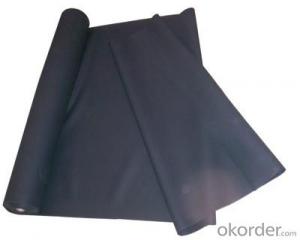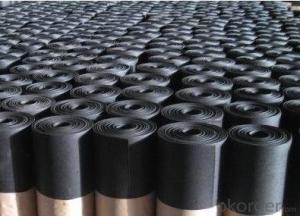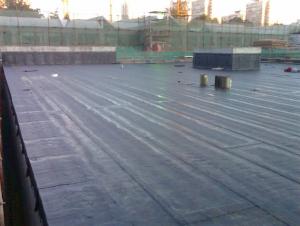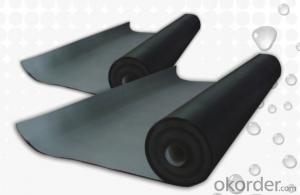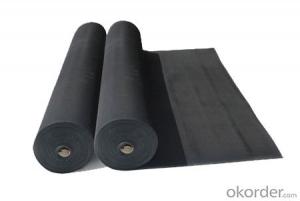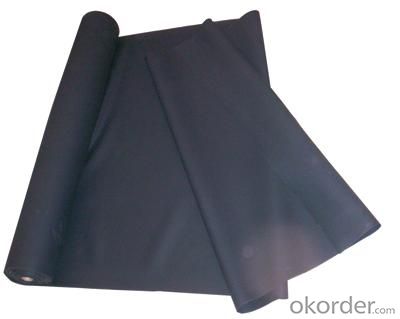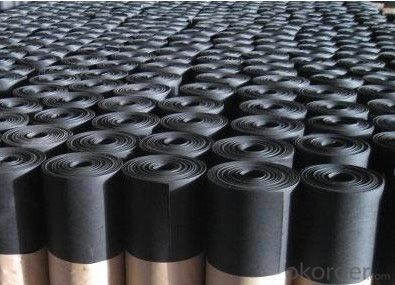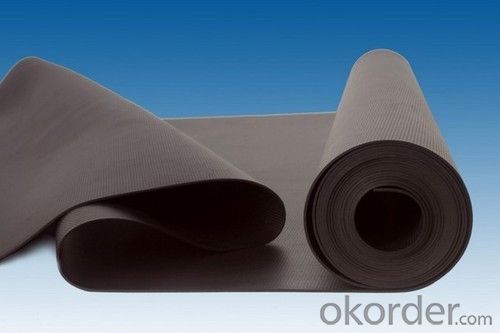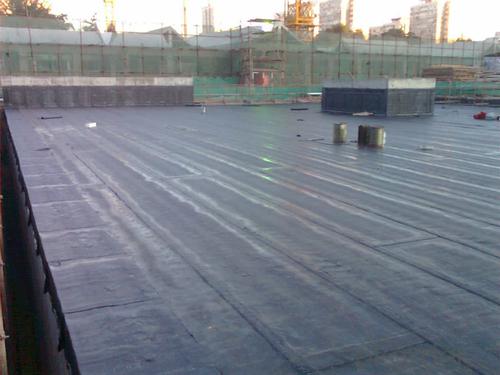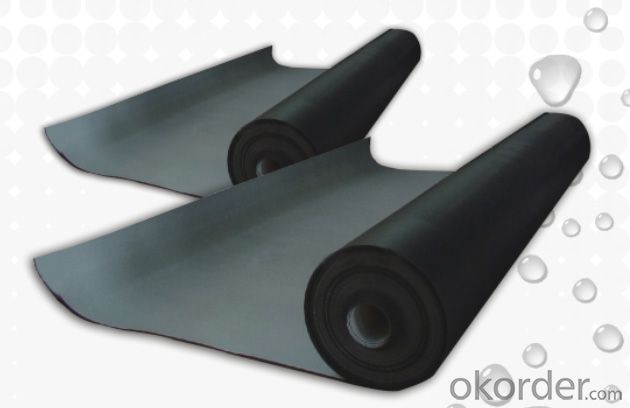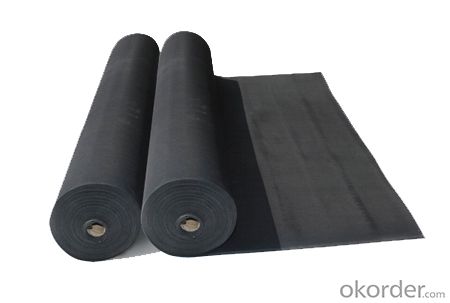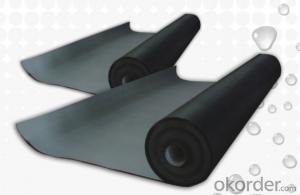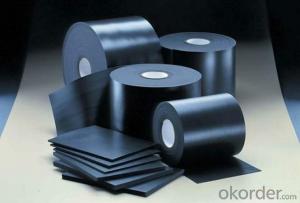EPDM Coiled Rubber Waterproof Membrane with 1.2mm Thickness
- Loading Port:
- Shanghai
- Payment Terms:
- TT OR LC
- Min Order Qty:
- 20000 m²
- Supply Capability:
- 5000000 m²/month
OKorder Service Pledge
OKorder Financial Service
You Might Also Like
EPDM Coiled Rubber Waterproof Membrane with 1.2mm Thickness
Description Of EPDM Coiled Rubber Waterproof Membrane with 1.2mm Thickness:
This waterproof coiled material is of high elasticity with best performance among high polumer
waterproof coiled material in the world.It is also the most typical one in the world.Waterproof coiled material made of ternary ethylene-propylene rubber is produced withthe use of the most advanced contiuous extrusion and vulcanization technology and related equipments which are specially designed for production of such product.It is good in compactness,without bubble and performance difference in length and breadth,perfomances reach or exceedthe demands of GB18173.1-2000 standard.
Main Features of EPDM Coiled Rubber Waterproof Membrane with 1.2mm Thickness:
A.Polyester based SBS Modified Bitumen Waterproofing Membrane
a. Strong impermeability
b. High tensile strength, elongation, ability to adapt the grassroots shrinkage deformation and cracking
c. Puncture-resistant, broken resistant, tear-resistant
d. The corrosion resistance, resistance to mildew, weathering good
e. Construction convenient, hot-melt can be operated Four Seasons Construction, reliable joints
B. Fiberglass based SBS Modified Bitumen Waterproofing Membrane
a. High tensile strength, stability of a good size
b. High Temperature good performance
c. Damage resistance, corrosion resistance, resistance to mildew, weathering good performance
d. Good construction performance, reliable joints.
Specifications of EPDM Coiled Rubber Waterproof Membrane with 1.2mm Thickness:
| Material | EPDM Rubber |
| Size | 1.2m (width)*20m (length) or customized, weldable type 2.05m or 4m width |
| Thick | 1.2mm, 1.5mm, 2.0mm |
| Type | Vulcanized & Weldable |
| Pattern | Non-reinforced (homogeneous) |
| Certificate | ISO9001/14001 |
Applications of EPDM Coiled Rubber Waterproof Membrane with 1.2mm Thickness:
1. Roofs, Basement, Toilet
2. Industrial and civil building waterproofing
3. Geo-synthetic liner for swimming pool, channels, irrigation system
4. Especially suit for projects with high requirements in durability, anti-corrosion and deformation
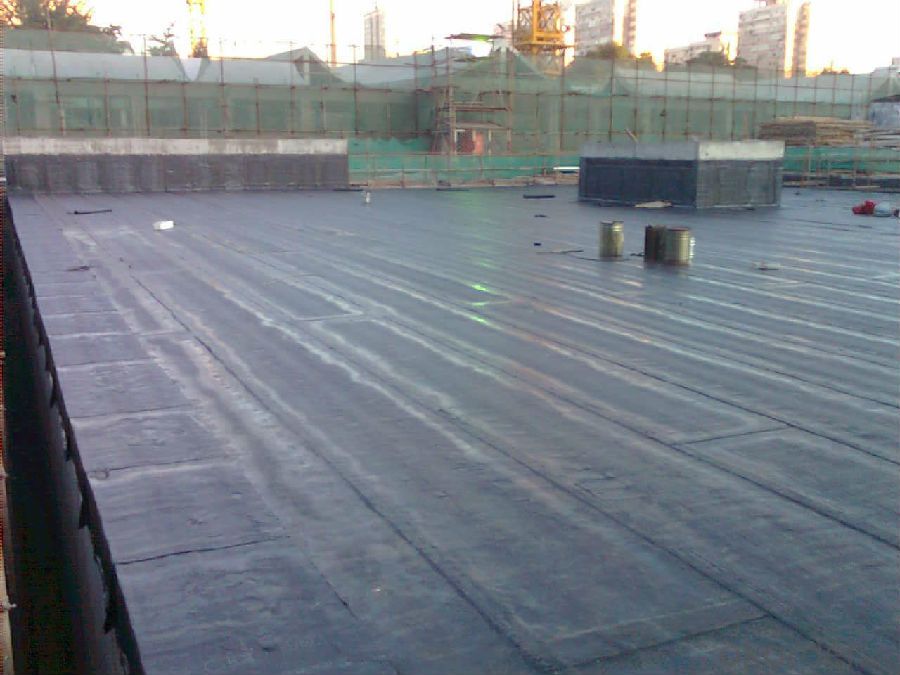
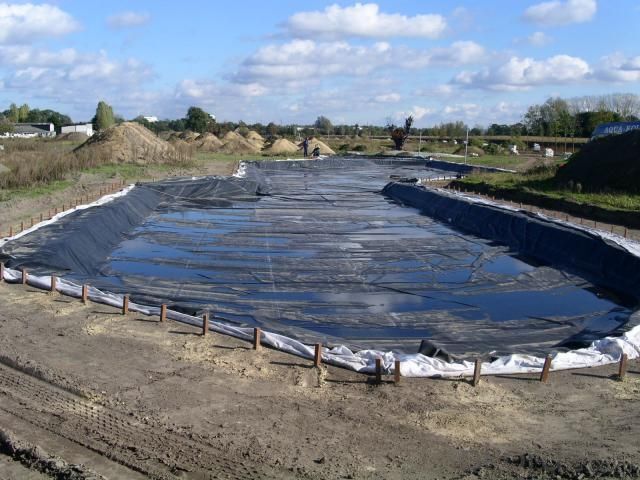

IMages of EPDM Coiled Rubber Waterproof Membrane with 1.2mm Thickness:




FAQ of EPDM Coiled Rubber Waterproof Membrane with 1.2mm Thickness:
1. What are we supplying?
We are specialized in producing Colorful Asphalt Roof Shingle, SBS/APP modified bitumen waterproof membrane, Self adhesive bitumen waterproof membrane, PVC waterproofing membrane, EPDM rubber roofing membrane, Single Component Polyurethane Waterproof Coating, and Spray Polyurea Waterproof Coating
.
2. How Many years experience do we have?
We have been exported to more than 20 countries in the past 15 years.
3. How long do we usually reply your request?
We always reply our customer within 24 hours.
- Q: How does a waterproofing membrane handle temperature fluctuations?
- A waterproofing membrane is designed to withstand temperature changes through its flexibility and resistance to thermal expansion and contraction. Temperature fluctuations have the potential to cause cracks, leaks, and other damage to materials. However, a waterproofing membrane is typically made from durable and flexible materials like PVC or EPDM, which can endure these temperature changes without compromising their effectiveness. When faced with high temperatures, the membrane will slightly expand to accommodate the increased thermal energy. Conversely, when temperatures decrease, the membrane will contract to maintain its integrity. This flexibility allows the membrane to adapt to changing conditions without cracking or becoming brittle. Besides flexibility, a waterproofing membrane is also engineered to resist the sun's UV radiation. Over time, UV radiation can cause materials to deteriorate, resulting in decreased performance and possible leaks. By incorporating UV stabilizers into the membrane's composition, it can endure prolonged exposure to sunlight and maintain its durability even in harsh weather conditions. Furthermore, certain waterproofing membranes possess built-in insulation properties that regulate temperature fluctuations. These membranes provide additional thermal resistance, reducing heat loss in cold weather and minimizing heat gain in hot weather. This insulation layer stabilizes the temperature of the underlying structure, preventing damage caused by extreme temperature changes. Overall, a waterproofing membrane is designed to handle temperature fluctuations by being flexible, resistant to thermal expansion and contraction, and capable of withstanding UV radiation. These attributes guarantee that the membrane remains intact and effective in safeguarding the underlying structure from water damage, regardless of the surrounding temperature conditions.
- Q: Can waterproofing membranes be used on foundation walls?
- Yes, waterproofing membranes can be used on foundation walls. Waterproofing membranes are specifically designed to prevent water infiltration and are commonly applied to foundation walls to protect them from moisture and water damage. These membranes are typically made of materials such as rubberized asphalt, thermoplastic, or PVC, which are durable and resistant to water penetration. They are installed on the exterior side of the foundation walls and provide an effective barrier against water, preventing it from seeping into the basement or crawl space. Waterproofing membranes are an essential component of building construction, as they help maintain the structural integrity of the foundation and prevent issues such as water damage, mold growth, and foundation settlement.
- Q: Is a waterproofing membrane resistant to root penetration?
- Yes, a waterproofing membrane is typically resistant to root penetration.
- Q: Can a waterproofing membrane be used in planter boxes or raised beds?
- To prevent water leakage and protect the structures around, one can make use of a waterproofing membrane in planter boxes or raised beds. The materials typically used for such membranes are rubber, PVC, or polyethylene, creating a barrier between the soil and the surrounding area. This barrier aids in retaining moisture within the planter box or raised bed, stopping water from seeping into the ground and potentially causing harm to the foundation or nearby structures. Additionally, the use of a waterproofing membrane also helps in preventing the leaching of chemicals or fertilizers from the soil, thereby enhancing the overall quality of the planting environment. However, it is crucial to ensure proper drainage in planter boxes or raised beds to avoid waterlogging and root rot.
- Q: How does a waterproofing membrane handle water pressure from adjacent structures?
- A waterproofing membrane is designed to handle water pressure from adjacent structures by creating a barrier that prevents water from penetrating through it. The membrane is typically installed on the exterior side of the structure, such as the foundation walls, and acts as a protective layer against water infiltration. The membrane itself is usually made of a durable and flexible material, such as rubber, PVC, or bitumen, that is resistant to water and can withstand the pressure exerted by water. It is installed in such a way that it forms a continuous and seamless barrier that covers the entire surface of the structure. When water pressure from adjacent structures, such as soil or groundwater, is exerted on the membrane, it resists the pressure and prevents water from seeping through. This is achieved through the combination of the membrane's material properties and the way it is installed. The waterproofing membrane is typically installed with proper surface preparation, ensuring that the surface is clean, smooth, and free from any debris or sharp objects that could potentially damage the membrane. It is then applied using adhesives, heat fusion, or mechanical fastening techniques to create a secure and watertight seal. In addition to the membrane itself, other components, such as drainage systems and protection boards, may be incorporated into the waterproofing system to further enhance its performance and manage water pressure effectively. These additional components help to divert water away from the structure and relieve any excess water pressure that may build up. Overall, a properly installed and maintained waterproofing membrane is designed to handle water pressure from adjacent structures by creating a reliable and durable barrier that prevents water infiltration and protects the structure from potential water damage.
- Q: Can a waterproofing membrane be used in commercial buildings?
- Yes, a waterproofing membrane can be used in commercial buildings. Waterproofing membranes are used to protect various parts of a building, including roofs, foundations, and basements, from water intrusion. In commercial buildings, where there may be a higher risk of water damage due to larger surface areas, increased foot traffic, and complex architectural designs, waterproofing membranes can provide an effective solution. These membranes are designed to create a protective barrier against water, preventing leaks, dampness, and potential structural damage. Additionally, waterproofing membranes can enhance the longevity of the building by reducing the risk of deterioration caused by water exposure. Thus, incorporating a waterproofing membrane system in commercial buildings can help maintain a safe and dry environment, protect valuable assets, and maximize the lifespan of the structure.
- Q: Can a waterproofing membrane be applied over existing waterproofing layers?
- Yes, a waterproofing membrane can be applied over existing waterproofing layers. However, it is important to assess the condition of the existing layers to ensure they are sound and can provide a proper substrate for the new membrane. Additionally, proper surface preparation and compatibility between the existing layers and the new membrane should be considered to ensure a successful and long-lasting waterproofing system.
- Q: Can waterproofing membranes be used on loading docks?
- Yes, waterproofing membranes can be used on loading docks. Waterproofing membranes are commonly used in various construction projects to prevent water infiltration and protect the underlying structure. Since loading docks are exposed to rain, snow, and other weather conditions, applying a waterproofing membrane can help to keep the dock area dry and prevent water damage.
- Q: Can a waterproofing membrane be used on brick walls?
- Brick walls, being porous, can absorb water and moisture, leading to damage and deterioration. To combat this, a waterproofing membrane can be applied. This membrane acts as a barrier, preventing water from entering the bricks while still allowing moisture to evaporate. By keeping the bricks dry, it reduces the risk of issues like efflorescence, mold, and mildew. Additionally, it improves the thermal insulation of the walls, reducing heat loss and enhancing energy efficiency. It is crucial to select a waterproofing membrane specifically made for masonry surfaces to ensure proper adhesion and long-lasting protection.
- Q: Can waterproofing membranes be used in swimming pools?
- Indeed, swimming pools can make use of waterproofing membranes. To prevent water leakage and safeguard the pool's structural integrity, it is common practice to employ waterproofing membranes in swimming pools. These membranes, often constructed from sturdy materials like PVC or EPDM, are specifically engineered to endure continuous exposure to water and pool chemicals. They are applied to the concrete or other pool structures, forming a watertight barrier that thwarts any seepage of water. Furthermore, waterproofing membranes offer an added layer of defense against cracks, corrosion, and other types of harm, thus guaranteeing the long-lastingness and resilience of the pool.
Send your message to us
EPDM Coiled Rubber Waterproof Membrane with 1.2mm Thickness
- Loading Port:
- Shanghai
- Payment Terms:
- TT OR LC
- Min Order Qty:
- 20000 m²
- Supply Capability:
- 5000000 m²/month
OKorder Service Pledge
OKorder Financial Service
Similar products
Hot products
Hot Searches
Related keywords
